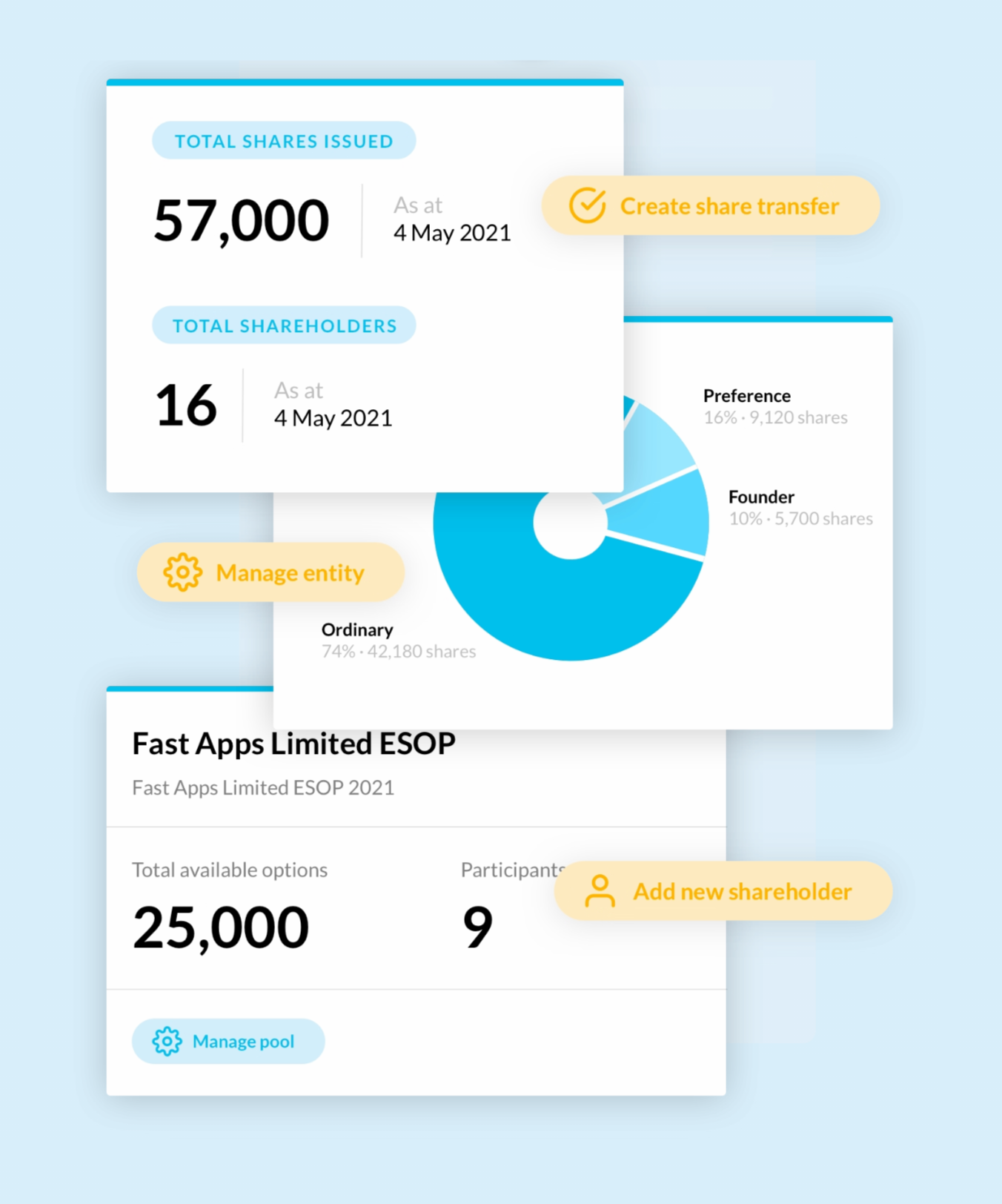
When you’re getting your business off the ground, there are a lot of decisions that need to be made. One of these is when to set up a cap table (sometimes referred to as a capitalisation table), which is an essential tool for monitoring and understanding equity ownership in your company.
Setting up a cap table early can help ensure clarity about who owns what portion of your startup and protect your interests over time. It also helps you make smart and informed decisions for hiring and finances, quickly and with accurate information at your fingertips.
The best time to get a cap table properly set up is before a company starts raising money. This will ensure that the company has accurate information on the ownership structure of the company and can share this information with potential investors. If a cap table is not set up before fundraising starts, it can be difficult to get accurate information later on.
In this article, we’ll go over best practices around establishing a cap table so you can make sure you set yourself up for success from the beginning.
Many business owners ask the question, “what is a cap table finance document?”, and you’ll find many different answers online. So, let’s delve into the what and why, in this section: cap tables explained.
A cap table is the backbone of a startup company or early-stage venture. It contains vital information about all securities, investors, and associated prices to provide an accurate breakdown of percentage ownership in the firm. This indispensable document shows how each investor's stake can be affected over time by funding rounds, IPOs, mergers & acquisitions and other transactions - making it key for long-term strategic planning. Without it, it has the potential to decrease the valuation of your company to potential investors, especially if it’s complicated and not well-managed.
A cap table is a key asset for modern entrepreneurs, venture capitalists, and investment analysts. By carefully managing multiple legal documents – including share issuances, transfers and conversions of debt to equity – it illustrates the evolution of an organisation's ownership from its beginnings. A transaction list records initial shareholders' shareholdings clearly showing how each has been impacted by events such as dilution or new securities issued over time.
There are good software providers that can help you do this as soon as your business venture kicks off, meaning you won’t have to worry about it at a future date. Orchestra can help simplify the entire process, get in touch with our team to get started.
Cap tables are like the skeleton key to unlocking visibility into company ownership structures. Through the management of legal documents and shareholder data, they provide a comprehensive overview for decision makers, advisors and potential investors. With this in mind, a cap table should be started sooner rather than later.
Here are some of the most important ways an investor cap table can help your business:
Negotiating new funding requires an understanding of the company's ownership structure. Investors are also concerned about their impact on other investors and want to ensure they sit in a privileged position for liquidity events - so that if any occur, they get repaid first. A cap table can provide insight into how existing equity holders will be diluted if a raise goes ahead, and to consider different scenarios to get to the best outcome for all involved.
Increasingly, companies are working to foster greater transparency with their employees about company ownership through employee share schemes. By helping them understand potential share payouts upon liquidation or sale of the firm, leaders can help employees understand the real benefit of participating in an employee share scheme. This can help maintain employee motivation by providing an ownership mindset even during times of financial difficulty - encouraging employee loyalty that transcends economic hardship.
From NZ to the US, cap tables are far more than simply a record of equity ownership. These documents not only keep track of who owns what but also can be used by tax authorities as evidence that everyone is keeping up with their dues. When kept updated properly, these records protect companies and employees alike from paying too much or not enough in taxes – making them indispensable tools for steering clear of costly mistakes.
When it comes to business sales, a cap table helps ensure that all shareholders get their fair share of profits. It outlines exactly how much each shareholder should receive from proceeds and in what order - making sure that any potential disputes or lawsuits are eliminated before they can arise.
Read these share register & stakeholder engagement mistakes to avoid.
In the earliest stages of building a business, most companies will use spreadsheets to create their cap table. However, for peace of mind, we would suggest using a software like Orchestra from an early stage so you don’t have to worry about double-handling data and updates as you grow.
The cap table should be designed in a simple and organised layout that clearly indicates who owns specific shares and the number of shares outstanding, as well as the presence of other equity instruments such as share option plans or convertible securities (refer to Convertible and SAFE Notes. How much equity do they cost?). After all, understanding how to read a cap table shouldn’t require more than a perfunctory understanding of the information it contains.
Your cap table should list ownership shares and the type of shares each investor, employee or founder holds. These entitlements designate who has control over major business decisions such as the reorganisation or even the sale of the company - but also signifies how much money will be returned during one-time payouts should preferred shareholders wish to liquidate their investments.
With more variables beyond just equity available for consideration, these days, businesses must take careful stock not only of actual shareholdings but also potential conditional ones as well if they are truly seeking an insightful picture of their portfolio performance.
Below is a preview of how Orchestra can help you streamline the creation and management of your company’s cap table over time.

Whether it be for expanding the employee option pool or a new round of funding, decisions made within your company can have serious repercussions on its equity structure. With a cap table private equity summary in hand, you will easily see what kind of changes are being proposed and how they affect shareholder groups. Before taking that plunge into fundraising waters with no life-jacket (ie, knowledge), get yourself set up with one so you know exactly what is slipping through your fingers.
Discussions about initial equity distributions are essential for helping get your venture off the ground successfully - that's why you need to create a cap table at the start of your venture. This tool will ensure honest dialogue between founders as they outline their respective shares in the new enterprise. With this document serving as proof of understanding at every step of the formation process, everyone involved will remain on equal footing throughout the adventure ahead.
For the successful hiring of new employees, it's essential to make sure their goals are in line with the company's objectives. A great way to do this is by offering them share options via an ESOP - a direct reflection of what they can contribute and how much appreciation they will receive from the organisation. With that comes keeping track via an ever-changing cap table that monitors authorised or available shares alongside those already issued over a rolling 12-month period.
Understanding how equity and company control shift with different financing rounds is key to making informed decisions. Knowing what-if scenarios helps founders anticipate future outcomes, set clear limits on investment levels, and determine when new options should be released for optimal benefits in the long run.
Learn more about managing your shareholder details with this overview on share registry.
Your cap table holds the keys to navigating any business decisions, from your next major fundraising round to hiring new employees. It's a snapshot of where you've been and will guide you on the journey ahead -- after all, knowing what information is in it and how best to use it can make those big calls easier. The best time to get a cap table properly set up is before a company starts raising money, and it is important to make sure that the information is accurate, the table is organised clearly, and it is accessible to all shareholders.
Managing a cap table can be complex and requires precise calculations displaying the ownership of all investors. This is where Orchestra can transform how you manage your information. Orchestra makes it easy to maintain your share registry and undertake cap table management.
Request a demo today and see how it can work for your business.
For more information on the topics covered, go to: